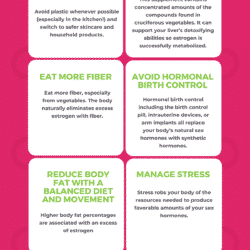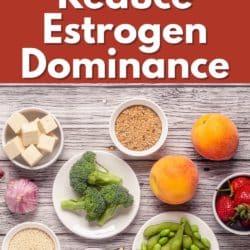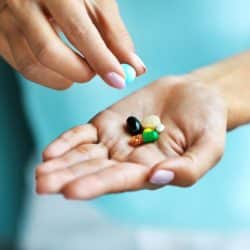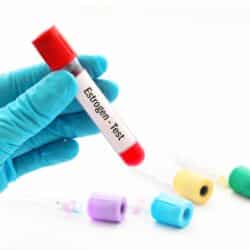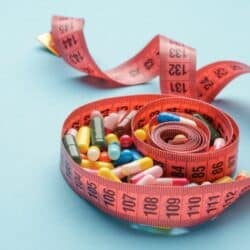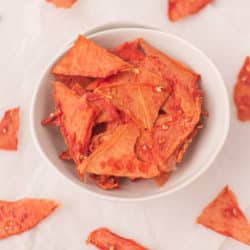7 Ways Naturally Treat Estrogen Dominance
Estrogen is important for the female body, but having too much of it can be problematic. Learn how to reverse estrogen dominance naturally and protect your body from its unpleasant symptoms.

What is Estrogen & Estrogen Dominance?
Estrogen is a key hormone primarily produced in the ovaries of female bodies, playing an essential role in regulating our menstrual cycle and reproductive systems. It also influences a variety of other physiological processes, assisting with our overall health and well-being.
Functions of Estrogen
- Menstrual cycle regulation: Controls the growth and maintenance of the uterine lining in preparation for a fertilized egg.
- Reproductive development: Aids in the development of secondary sexual characteristics during puberty, such as breast development and the distribution of body fat.
- Bone health: Helps in the maintenance of bone density, reducing the risk of osteoporosis.
- Heart health: Assists in maintaining the health of the arterial walls.
- Mood and brain function: Can influence mood and may play a role in maintaining cognitive health.
- Skin and hair: Contributes to the maintenance of skin elasticity and may affect hair growth patterns.
- Cholesterol regulation: Affects levels of cholesterol in the blood, promoting higher levels of HDL (good cholesterol) and lower levels of LDL (bad cholesterol).
Estrogen Dominance
Estrogen dominance is a hormonal imbalance in which a woman’s estrogen levels are too high. There are certain unpleasant symptoms and health risks that can occur with estrogen dominance, including certain cancers.
Estrogen dominance can be categorized in two ways: frank estrogen dominance and relative estrogen dominance. While both have similar symptoms, the causes differ.
Frank estrogen dominance is an excess of estrogen on its own, while other sex hormone levels (such as testosterone and progesterone) are at normal levels. Relative estrogen dominance occurs when a woman’s estrogen levels are elevated in relation to her progesterone levels, which are often too low.
Symptoms of Excess Estrogen in Females
Likely, you’ll know if you have a hormonal imbalance. Estrogen dominance in particular has a range of unpleasant symptoms that can be hard to ignore.
Common symptoms of estrogen dominance include:
- Heavy or painful periods and/or fibroids, including the condition endometriosis
- Premenstrual syndrome, often characterized by cramps, fatigue, and mood swings
- Headaches, including premenstrual or menstrual migraines
- Weight gain localized in the abdomen, hips, and thighs
- Low libido
- Bloating around or during your period
- Tender or swollen breasts around or during your period
- Irregular or abnormal cycles
See my full article on the symptoms of estrogen dominance and how to address it naturally.
Causes of High Estrogen Dominance
Here are a few common reasons for estrogen dominance.
Estrogen Exposure
Girls and women around the world are being exposed to more estrogen in our diets and environments than ever before.
- Phytoestrogens are estrogen-like compounds found in foods like soy and flax. When consumed excessively, phytoestrogens from foods can lead to estrogen dominance.
- Xenoestrogens are human-made compounds that mimic our natural estrogens, causing estrogen dominance. These compounds are found in synthetic hormones such as birth control pills, plastics, and common chemicals in household products and cosmetics.
No matter the source, too much exposure to outside estrogens can lead to a hormonal imbalance or estrogen dominance.
Perimenopause
Perimenopause refers to the time period in a woman’s life before menopause officially occurs. This time is characterized by fluctuating hormone levels as the body prepares to transition from its fertile years.
A common cause of estrogen dominance–and subsequent unpleasant symptoms–during perimenopause is low progesterone as ovulation begins to slow down. This is because adequate progesterone levels can only be produced by successful ovulation.
For this reason and others, perimenopause is a phase when women may experience low progesterone, high estrogen, and symptoms of estrogen dominance.
See my related articles on foods to help increase progesterone and how to reduce bloating during perimenopause.
Progesterone Deficiency
With relative estrogen dominance, estrogen is too high in relation to progesterone. If adequate progesterone is not produced, estrogen dominance often occurs.
Some causes of progesterone deficiency include stress and unsuccessful ovulation. This can lead to estrogen dominance for women of any reproductive age.
Poor gut health
An enzyme called beta-glucuronidase is produced in your gut by certain bacteria. If you have poor gut health, then you could produce too much of this enzyme. This will then cause metabolized estrogen to re-enter circulation in the body and cause symptoms of estrogen dominance.
Also, poor gut health usually equals poor digestion. Digestion and successful elimination is crucial to rid your body of excess hormones.
See my related articles with the best gut healing foods and a leaky gut diet plan.
How to Flush Out Excess Estrogen
1. Avoid environmental estrogens
If you want to get your estrogen balance back under control, you may have to make some changes to your environment.
Try to avoid the xenoestrogens mentioned above, including chemicals, plastics, and synthetic hormones.
Avoid plastic whenever possible (especially in the kitchen!) and switch to safer skincare and household products. The EWG Skin Deep database is a great resource for checking your products for chemicals that should be avoided.

2. Consider supplements
The supplement DIM, short for 3,3′-Diindolylmethan, contains concentrated amounts of the compounds found in cruciferous vegetables. It can support your liver’s detoxifying abilities so estrogen is successfully metabolized.
You may also want to talk to your doctor or healthcare provider about supplementing with micronized progesterone or progesterone cream. Both of these can help balance female hormones during perimenopause when natural levels of progesterone decrease.
You can purchase both DIM and progesterone creams online, but you’ll need to get a prescription if you want to take oral micronized progesterone. Talk to your doctor before making any changes to your supplement routine.
Also, don’t miss my related articles on the best supplements to reduce estrogen dominance, best supplements for hormone balance, the best supplements for women in their 30s and the best supplements for women over 50.
3. Lower estrogen with fiber
Eat more fiber, especially from fruits and vegetables. The body naturally eliminates excess estrogen with fiber. This is part of your overall digestion; you must be eliminating regularly to rid your body of excess estrogen.
In particular, you may also want to emphasize eating foods including:
- blueberries,
- strawberries,
- peaches,
- nectarines,
- apples,
- pears,
- carrots,
- lettuce,
- and other vegetables.
These foods have been studied for their role in reducing the incidence of hormone-related breast cancer. This may be due to the fiber and antioxidants contained in these foods.
You may also want to try incorporating a Raw Carrot Salad into your diet to help with estrogen metabolism.
Learn more about how to eat more green vegetables. You may also like this article with the best diets to reduce estrogen.
That said, some women who are experiencing estrogen dominance may also benefit from a restricted diet such as a low-histamine diet to help manage symptoms.
But, don’t necessarily start restricting your diet until you’ve worked with a functional medicine doctor who can help determine the root causes of your estrogen dominance (find a functional medicine doctor near you).
4. Fix your gut so you have more enzymes that metabolize estrogen
A healthy gut lining and microbiome is essential for producing the right amount of the right enzymes to metabolize estrogen.
Do your best to eat lots of healthy foods and avoid too much add sugar or processed foods that are bad for gut health.
Other activities that can harm gut health include taking antibiotics, drinking too much alcohol, not exercising enough, not getting enough sleep, and not managing your stress.
Read about the top 10 foods with natural probiotics to help with gut health. You might also want to check out this list of the best gut healing foods.
If you are experiencing chronic digestive issues, you should talk to your healthcare provider to develop a plan to help reduce gut inflammation and to help improve the integrity of your digestive system.
5. Reduce body fat with a clean eating diet and movement
Higher body fat percentages are associated with an excess of estrogen, as estrogen is partially produced by adipose tissue. Consult your doctor or healthcare provider to see if you would benefit from reducing your body fat by a certain amount.
If you are new to eating healthy, then be sure to get my clean eating shopping list or see my post on how to eat clean. You may also want to check out my clean eating recipe index with hundreds of free recipes!
Additionally, for extra help with weight loss resistance, check out these tips for women who are having trouble losing weight no matter what.
6. Manage stress
Stress robs your body of the resources needed to produce favorable amounts of your sex hormones.
When your body is prioritizing making cortisol due to high levels of stress, there isn’t enough pregnenolone left over to make progesterone, causing relative estrogen dominance.
Stress can also suppress ovulation, further decreasing your chances of progesterone production.
You may like this article on holistic health tips for beginners if you are just getting started on natural ways of healing.
7. Avoid hormonal birth control
Hormonal birth control including the birth control pill, intrauterine devices, or arm implants all replace your body’s natural sex hormones with synthetic hormones.
Hormonal birth control works by flooding your body with synthetic estrogen and progestin to mimic pregnancy so you will not ovulate.
The increased levels of these xenoestrogens can lead to estrogen dominance once you stop taking hormonal birth control, as your body attempts to regulate its own hormones and metabolize the synthetic hormones.
Instead of using hormonal birth control that can lead to estrogen dominance, consider non-hormone types of birth control including the fertility awareness method, vasectomy, or other types of natural birth control.
Bonus Recommendation: Consider Phytoestrogens
Phytoestrogens are compounds found in plant foods that resemble our natural estrogen.
There is some evidence that consuming unprocessed forms of phytoestrogens such as whole food soy, garlic, potatoes, apples, pomegranates, and coffee can help balance the body’s production of estrogen.
Try introducing some of these foods into your diet and see if you feel less symptoms of estrogen dominance.
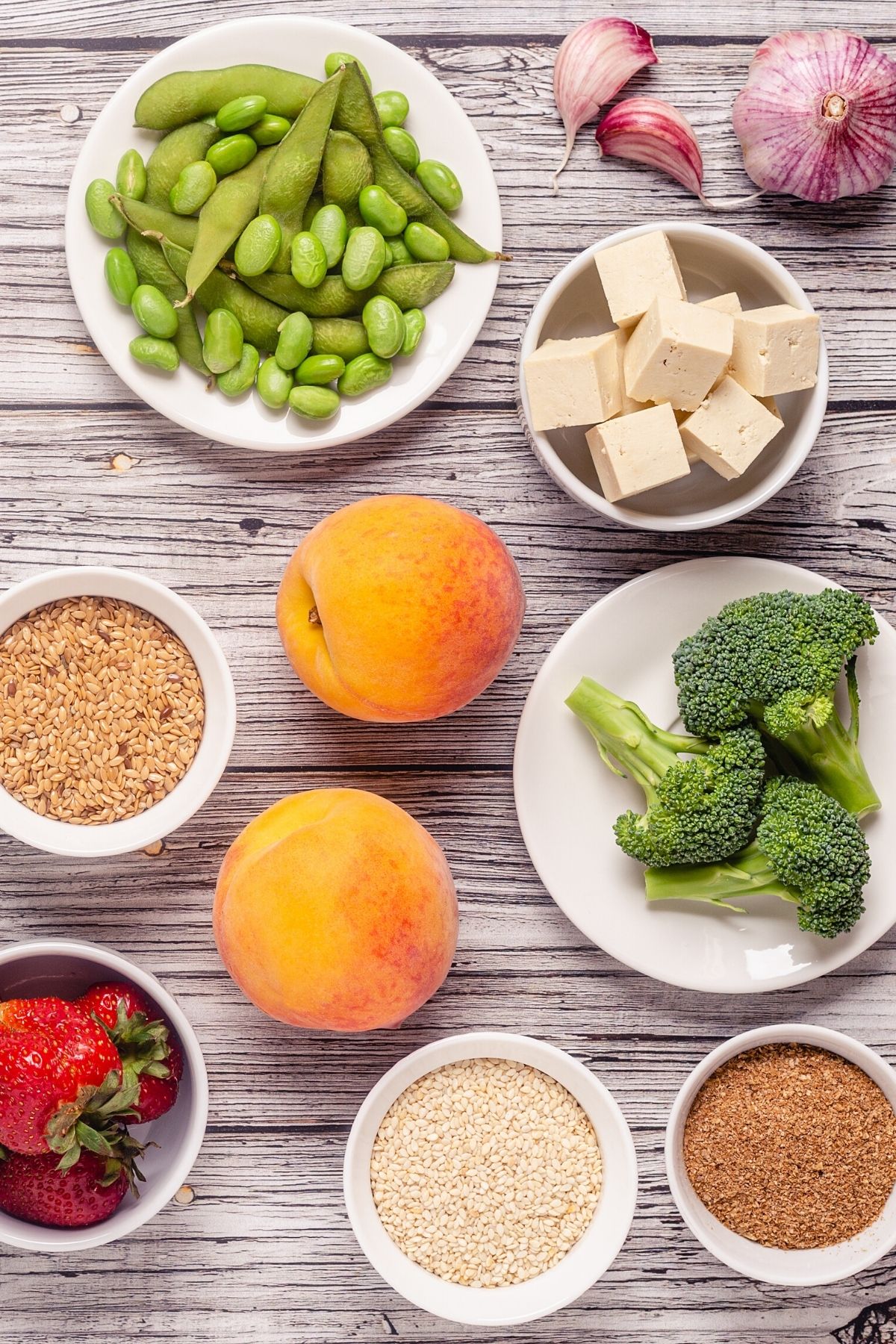
FAQs About Estrogen Dominance Treatment
You can help your body reduce excess estrogens by eating more fiber, exercising, limiting alcohol, and even taking some supplements that can help metabolize estrogen. You may also try eating a raw carrot 1-2 times a day to help with estrogen metabolism. Or try my Raw Carrot Salad recipe.
There is not just one best food. Choose from a variety of estrogen and hormone-balancing foods including cruciferous vegetables, raw carrots, fatty fish, fiber-rich foods, and more. Avoid sugary foods and alcohol. Be sure to speak to your doctor to help personalize an estrogen-balancing diet for your individual needs.
Reducing estrogen levels may require dietary adjustments. It’s may be helpful to limit eating conventional dairy products which can have estrogenic effects. It may also be advisable to curb alcohol consumption, avoid cooking with plastics made with BPA and phthalates, and minimize eating processed foods and refined sugars that can indirectly raise estrogen. Consider working with a dietitian or your healthcare provider to help create a specialized nutrition or health plan that may help reduce estrogen levels.
Several compounds and vitamins can influence estrogen levels in females. Diindolylmethane (DIM), a component of cruciferous vegetables, aids in metabolizing estrogen into milder forms. Calcium D-Glucarate, another compound, helps the body detoxify and eliminate excess estrogen.
Vitamins like vitamin B6 and vitamin E may also help by supporting the liver and hormone balance.
In women, high estrogen can manifest as symptoms such as bloating, breast tenderness, irregular menstrual cycles, mood swings, and weight gain, particularly around the stomach. If you suspect elevated estrogen levels, you can ask your doctor for a blood test (you may also wish to test for progesterone at the same time).
Vitamin D has a complex relationship with estrogen. Some research suggests that vitamin D can influence the synthesis and metabolism of estrogen within the body. However, its direct role in reducing or increasing estrogen levels isn’t fully established, and more research is needed to draw definitive conclusions.
Magnesium is thought to play a role in hormone regulation, including estrogen balance. Some studies suggest that magnesium can help increase the efficiency of estrogen detoxification in the liver. However, while magnesium might support overall hormone balance, its direct impact on estrogen levels requires further research for clarity.
More Helpful Hormone Articles You Might Like
Conclusions
Estrogen dominance can be caused by environmental estrogen exposure, poor gut health, and often, progesterone deficiency. This condition can cause symptoms like painful periods, PMS, and weight gain and increases the risk of certain cancers.
Estrogen dominance may be addressed naturally by focusing on a nutrient-dense diet, reducing stress, limiting your exposure to environmental estrogens, and improving gut health.
About the Author: Carrie Forrest has a master’s degree in public health with a specialty in nutrition and is a certified holistic nutritionist. She is a top wellness and food blogger with over 5 million annual visitors to her site. Carrie has an incredible story of recovery from chronic illness and is passionate about helping other women transform their health. Send her a message through her contact form.
Don’t forget to join my newsletter list to get exclusive clean eating recipes and tips. The newsletter is 100% free with no spam; unsubscribe anytime.
Note: this post is for informational purposes only and is not intended as medical advice. Please consult your healthcare provider for recommendations related to your individual situation.


